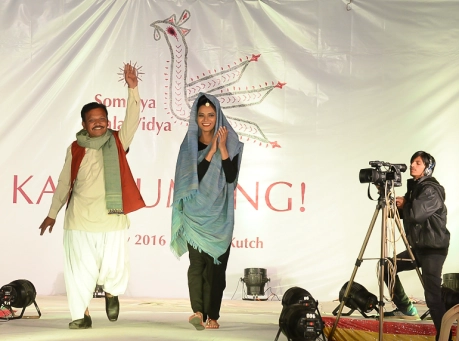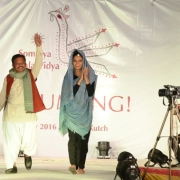 Poonambhai, a weaver from Varnora, graduated from the Somaiya Kala Vidya design course last year. He had actually begun the course in 2013, but at the time of the second session he had an opportunity to go to Delhi for a sale, so he went, saying he would be back in a few days. He missed the whole course and we said he could not continue. He realized he wanted to complete the course, so two years later, at age 40, he came again, starting over from course one.
Poonambhai, a weaver from Varnora, graduated from the Somaiya Kala Vidya design course last year. He had actually begun the course in 2013, but at the time of the second session he had an opportunity to go to Delhi for a sale, so he went, saying he would be back in a few days. He missed the whole course and we said he could not continue. He realized he wanted to complete the course, so two years later, at age 40, he came again, starting over from course one.
Poonambhai lost his father, also a weaver, when he was only twelve years old. The family had no income, so he went to Bhujodi to learn weaving, and wove as a job worker there until he got married at nineteen. Returning to Varnora, with no savings and no business experience, he managed to make some products. Then he learned about the DCH (a government agency that deals with craft) from fellow weavers. He immediately contacted the office and was invited to an exhibition in Guwahati, Assam.
Without knowing where Guwahati was, Poonambhai went. And he earned RS 70,000– plus the subsidy the government offers. From then he has largely depended on government exhibitions for his livelihood.
In his admission interview at SKV, Poonambhai said he considers his art a means of livelihood and achieving social respect. A good design, he said, is one that no one, not even the artisan who made it, can copy exactly.
A year ago, in the Concept Development course, Poonambhai chose a subtle cool pastel colour palette from the trend forecast. He was intrigued because he had never used such colours before, he said, and he named his theme “Air.”
This week, as the Concept Development course was in session, Poonambhai breezed into our office, bright, confident, happy. He was supposed to come on Sunday, but he said he had been in a two-day meeting for a huge government program. Though Poonambhai has run after government programs for much of his life, I saw a difference. Of course he will take advantage of their opportunities. But he’s not desperate or dependent now. He knows he has better markets and good products.
He happily relates how well his collection sold and lists the people who bought pieces and ordered– high level clients, several international. He says the design course changed his life, so he sent his nephew to take it this year.
Poonambhai intently studied the theme boards that his nephew and the other students had made, and examined the experiments they were doing in weaving, printing and bandhani. He was excited to look at the 2016-17 trend forecast.
Then he asked if he could use one for his own work?
Of course.
He sat with Lokesh, the faculty member, and looked at each story. He chose one, another palette of subtle tones. And then he volunteered to go out and get print outs.
I was struck by his willingness to make this effort. No hesitation and no thought of subsidy.
I remembered Poonambhai in course one, buffering himself with an armory of excuses. He can’t hear, he can’t remember, he is too old to do these exercises… And as soon as he had he developed the theme “Air,” he wanted to change it. It needed a bright pink– something more familiar. He was upset that he could not change the colours; he was sure no one would like them. Even after Ritu Kumar chose his work for a fashion show she was presenting, he wanted to bring the old products for his final show in Mumbai.
But his collection sold- every last piece. And now he has orders on it to fill.
Poonambhai has long forgotten about his excuses, and his age.
This is the real gift in the work I do: priceless.


